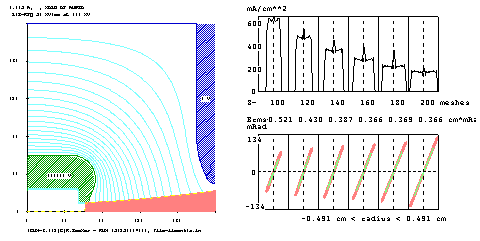| Extraction of ions from plasmas and
trajectory optics
The equivalent program to EGUN that can simulate the sheath of a plasma ion source has been called IGUN. It has POLYGON and ANALYSE as integral part, so only GPED and CPLCOMP may be needed for pure electrostatic problems. The combination with magnetic fields is very simple by reading the output file of INTMAG, which can be used by IGUN to plot on top of a magnetostatic problem - solved by INTMAG - the boundaries of the electrostatic problem. Another feature of IGUN are “live” – colored - plots of equipotentials and trajectories during execution (for the moment under WINDOW-XP, we only can supply a version without interactive graphics). This is also a useful diagnostic in order to “see” problems in convergence or in the definition of the parameters. As an example here, we will show the matching of a C6+ beam from a high intensity laser ion source to a RFQ. For this, a special feature has been supplied to IGUN: The rf-focusing inside the matching section of the RFQ, where no modulation occurs, can be taken into account by a virtual reduction of the beam current, which otherwise only accounts for the beam spreading by space charge. |

|
|
The first plot shows only the direct extraction
region for the laser ion source. Dividing up large problems
has great advantage for stability of convergence and speed of
computation. In the case of the example given, the plasma region
needs more mesh resolution, in order to provide a physically
sound simulation of the plasma meniscus. The matching section,
however, does not need this high resolution and will converge
much faster with bigger mesh size, without loosing physical
significance. Here is the matching section to the RFQ, using
the replacement of rf-focusing by appropriate reduction of space charge
beam spreading:
|

|
|
For the present example the surface field strength
has been especially important in order to reduce sparking and
provide a stable operation. The feature of IGUN was used, to
plot the surface fields together with a related outline of the
boundaries, in order to reduce the field strength in the “hot
spots” on relative negative potential. The aim, to limit there
the surface field to less than 30 kV/cm has lead to a specific
design of the electrodes with two radii of rounding.
|
|
|
